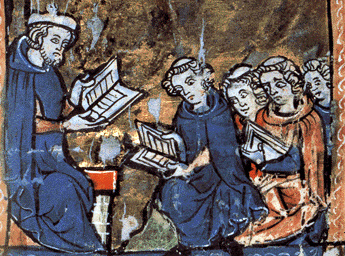Fragments §
Edited by Kari Ellen Gade
gránn ‘The grey’
[3] gránn (m. nom. sg.) ‘grey’: All mss have gráns (m. gen. sg.) ‘of the grey’, which makes no sense syntactically. The adj. can qualify either sær m. nom. sg. ‘sea’ or hlunnvisundr m. nom. sg. ‘ship’. Since the wood of the ship is described as ‘red’ (rauðan við) (l. 2), the former is more likely. The adj. gránn can also mean ‘dangerous’, but in light of the colour imagery that pervades this stanza, the meaning ‘grey’ has been adopted.
Closeþars ‘where’
[3-4] þars hlunnvisundr gínn golli búnum munni ‘where the roller-bison [SHIP] gapes with its gold-adorned mouth’: This refers to the golden ornamental animal head affixed to the prow of a ship (see Falk 1912, 105-7 and Jesch 2001a, 127-8). For similar imagery of the ocean playing with such golden heads on a royal vessel, see Valg Har 10II, 11/1-4II.
Closegolli ‘with its gold’
[3-4] þars hlunnvisundr gínn golli búnum munni ‘where the roller-bison [SHIP] gapes with its gold-adorned mouth’: This refers to the golden ornamental animal head affixed to the prow of a ship (see Falk 1912, 105-7 and Jesch 2001a, 127-8). For similar imagery of the ocean playing with such golden heads on a royal vessel, see Valg Har 10II, 11/1-4II.
Closebúnum ‘adorned’
[3-4] þars hlunnvisundr gínn golli búnum munni ‘where the roller-bison [SHIP] gapes with its gold-adorned mouth’: This refers to the golden ornamental animal head affixed to the prow of a ship (see Falk 1912, 105-7 and Jesch 2001a, 127-8). For similar imagery of the ocean playing with such golden heads on a royal vessel, see Valg Har 10II, 11/1-4II.
Closegínn ‘gapes’
[3-4] þars hlunnvisundr gínn golli búnum munni ‘where the roller-bison [SHIP] gapes with its gold-adorned mouth’: This refers to the golden ornamental animal head affixed to the prow of a ship (see Falk 1912, 105-7 and Jesch 2001a, 127-8). For similar imagery of the ocean playing with such golden heads on a royal vessel, see Valg Har 10II, 11/1-4II.
Closehlunn ‘the roller’
hlunnr (noun m.; °-s, dat. -i; -ar): roller < hlunnvisundr (noun m.)
[3-4] þars hlunnvisundr gínn golli búnum munni ‘where the roller-bison [SHIP] gapes with its gold-adorned mouth’: This refers to the golden ornamental animal head affixed to the prow of a ship (see Falk 1912, 105-7 and Jesch 2001a, 127-8). For similar imagery of the ocean playing with such golden heads on a royal vessel, see Valg Har 10II, 11/1-4II. — [4] hlunnvisundr ‘the roller-bison [SHIP]’: Hlunnr was one of the post that supported a ship on the shore or was used as a roller in a slipway.
Closehlunn ‘the roller’
hlunnr (noun m.; °-s, dat. -i; -ar): roller < hlunnvisundr (noun m.)
[3-4] þars hlunnvisundr gínn golli búnum munni ‘where the roller-bison [SHIP] gapes with its gold-adorned mouth’: This refers to the golden ornamental animal head affixed to the prow of a ship (see Falk 1912, 105-7 and Jesch 2001a, 127-8). For similar imagery of the ocean playing with such golden heads on a royal vessel, see Valg Har 10II, 11/1-4II. — [4] hlunnvisundr ‘the roller-bison [SHIP]’: Hlunnr was one of the post that supported a ship on the shore or was used as a roller in a slipway.
Closevisundr ‘bison’
nom.
vísundr (noun m.; °dat. -i; -ar): bison < hlunnvisundr (noun m.)
[3-4] þars hlunnvisundr gínn golli búnum munni ‘where the roller-bison [SHIP] gapes with its gold-adorned mouth’: This refers to the golden ornamental animal head affixed to the prow of a ship (see Falk 1912, 105-7 and Jesch 2001a, 127-8). For similar imagery of the ocean playing with such golden heads on a royal vessel, see Valg Har 10II, 11/1-4II. — [4] hlunnvisundr ‘the roller-bison [SHIP]’: Hlunnr was one of the post that supported a ship on the shore or was used as a roller in a slipway.
Closevisundr ‘bison’
nom.
vísundr (noun m.; °dat. -i; -ar): bison < hlunnvisundr (noun m.)
[3-4] þars hlunnvisundr gínn golli búnum munni ‘where the roller-bison [SHIP] gapes with its gold-adorned mouth’: This refers to the golden ornamental animal head affixed to the prow of a ship (see Falk 1912, 105-7 and Jesch 2001a, 127-8). For similar imagery of the ocean playing with such golden heads on a royal vessel, see Valg Har 10II, 11/1-4II. — [4] hlunnvisundr ‘the roller-bison [SHIP]’: Hlunnr was one of the post that supported a ship on the shore or was used as a roller in a slipway.
Closemunni ‘mouth’
munnr (noun m.; °-s, dat. -i; -ar): mouth
[3-4] þars hlunnvisundr gínn golli búnum munni ‘where the roller-bison [SHIP] gapes with its gold-adorned mouth’: This refers to the golden ornamental animal head affixed to the prow of a ship (see Falk 1912, 105-7 and Jesch 2001a, 127-8). For similar imagery of the ocean playing with such golden heads on a royal vessel, see Valg Har 10II, 11/1-4II.
CloseTeaching text: text section
Here you can see a piece of text. Clicking on words in the text will show you the dictionary headword, grammatical information and notes on how the word is used.
You should pay careful attention to the explanation of each word. You can test your knowledge using the translation and other exercises.
In some cases there may be audio of a modern Icelandic rendition of the text on this page.
